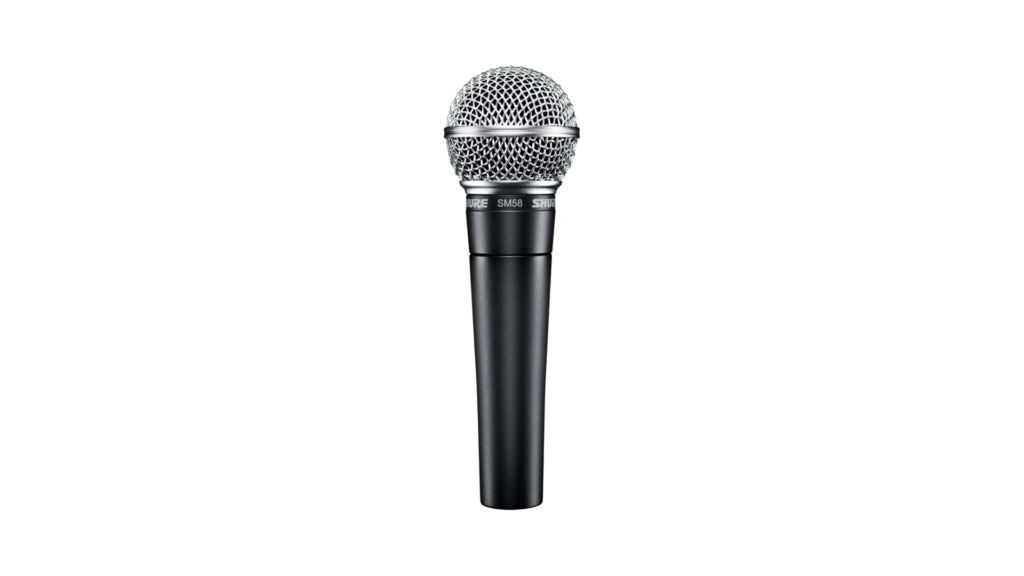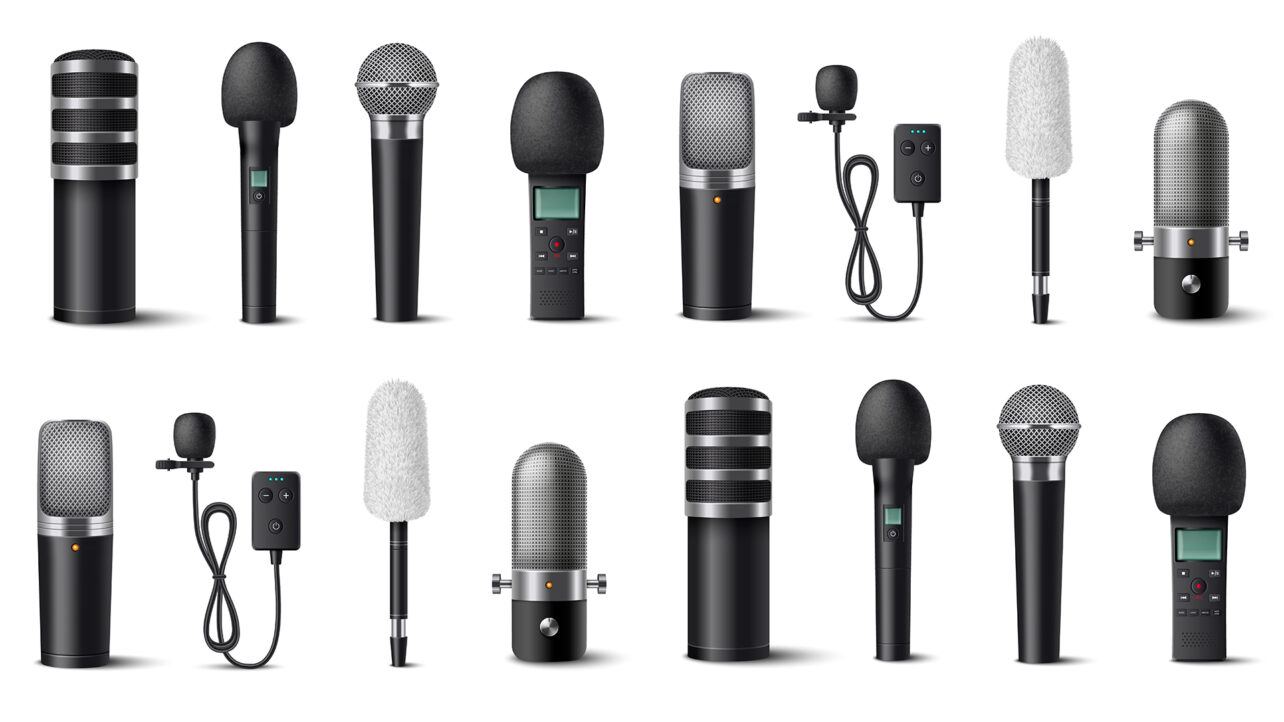The art of sound recording is exciting, rewarding, and fascinating. If you are new to the audio world, fear not, as we have compiled a list of various microphones used in the creative industry. Discover the many great and unique microphones within the creative industry today, from your standard studio to an underwater microphone.
Dynamic Microphones
The most robust microphones on this list, the dynamic microphones, are designed to handle large amounts of sound pressure (SPL), are resistant to handling noise, and are built to last, making them ideal for live performances.

The types of dynamic microphones seen with artists like Taylor Swift or Beyoncé on stage are also known as moving coil microphones. The coil, attached to the diaphragm at the back, is surrounded by a strong magnet. When sound hits the diaphragm, it vibrates the coil. This movement within the magnetic gap creates an electrical signal, converting analogue sounds to electrical signals. Though robust and affordable, these microphones may not deliver the same level of accuracy as some studio microphones.
Recommendations:
- Shure SM58 – $99
- EV RE20 – $449
- Universal Audio SD-1 – $229
Condenser Microphones
The condenser microphone, favored in studio settings for its sensitivity and high fidelity, captures sound with exceptional detail. Its core components—the diaphragm and backplate—are responsible for converting sound into electrical signals.
The diaphragm, typically made of mylar, vibrates upon contact with sound waves, altering the distance from the backplate and changing capacitance, thus producing an electrical signal, albeit weak. To boost this signal, condenser mics have an onboard preamp, which requires external power, commonly supplied via 48V phantom power from an audio interface.
Condenser microphones come in two main sizes: large and small. Large condensers have larger diaphragm membranes, giving them a broader frequency response and warmer sound. This contributes to their colorful character, which works well for recording the human voice to reveal its many nuances. On the other hand, small condensers featuring a narrower diaphragm offer more natural and precise sound reproduction, making them ideal for recording sounds with distinct transient responses and precision recording tasks.
Prices vary depending on build quality and factors like noise level and SPL. However, companies like RODE and Lewitt offer budget-friendly condensers that perform at fantastic levels.
Here’s a video from Lewitt, who have introduced a new large condenser microphone that adapts to your proximity and has embedded mute-by-distance technology, perfect for streamers—a game changer!
Recommendations:
- RODE NT1 (Large Condenser) – $249
- RODE NT5 (Small Condenser) – $219
- Lewitt RAY Condenser Microphone (Large Condenser) – $349
- Audio Technica AT4022 (Small Condenser) – $349
Shotgun Microphones
Looking up shotgun microphones, you might think, “Hey, this looks similar to a small condenser.”
Well, yes, a shotgun microphone is in the same ballpark and is a staple piece of equipment in the filmmaking industry. What sets them apart from small condenser microphones is their narrower pickup patterns and better side rejection, making them an excellent choice for boom operators when capturing on-set dialogue.
Your text is well-explained and clear. Here’s a proofread version with minor adjustments for clarity and flow:
Looking more into the infrastructure of a shotgun microphone, the small diaphragm sits at the end of a hollow tube known as the interference tube. This design ensures that sound directly in front of the microphone travels straight down the tube. Notice the small slots on the side of the microphone? These allow off-axis sound to enter. Because the sound travels through different slots at varying distances from the diaphragm, phase issues occur, which in turn cancel each other out. This technology provides better side rejection for optimal directionality.
Shotgun microphones can be either long or short. Longer shotgun microphones are better suited for long-range recordings but are typically more expensive.
Recommendations:
- Audio Technica AT8035 – $269
- Sennheiser MKE 600 – $290
- RODE NTG2 – $296
Lavalier Microphones
All of these microphones mentioned until now are pretty portable but don’t allow for much freedom of movement. You either need to be holding it or position yourself directly in front of the mounted microphone. If you are a content creator who likes to move about without holding a microphone and not have to worry about audio clarity, the lavalier microphone will do just the trick.
Lavalier microphones are tiny microphones that can be attached to the lapel of your clothing using a clip. They employ an omnidirectional polar pattern, meaning they pick up sound from all directions, so you won’t need to worry about whether you’re off-axis from the microphone.
Usually, a lav mic will only need to be plugged into your camera via a 3.5mm jack connector. However, more expensive models will have a transmitter and receiver, allowing you to be fully wireless from your camera. These are highly beneficial for content creators who like to take long shots or move around a lot. Lastly, they are lightweight, portable, and easy to conceal.
Recommendations:
- RODE Wireless GO – $199
- Sennheiser EW 112P G4 – $829
- Audio Technica AT831B – $109
Ribbon Microphones
Remember the dynamic microphone we mentioned first on this list? There is another type of dynamic microphone called the ribbon microphone.
Ribbon microphones are recognized for their utmost delicacy and sensitivity due to their extremely thin piece of metal (the ribbon) suspended in a strong magnetic field within the microphone itself.
Ribbon microphones are prized for their subdued and warm quality, attributed to their affinity for lower frequencies and lower output than standard condenser microphones. But with a bit of EQ shaping, higher frequencies can be enhanced while still maintaining a warm sound. Ribbon microphones need a good pre-amp to further outshine their unique sound.
These microphones are standard for recording electric guitar cabinets but can also be used in other instrument applications like strings, drums, and vocals. Ribbons are also fantastic dialogue microphones due to their deep sound reproduction, complementing the human voice nicely.
A general tip for using ribbon microphones is that they should be handled carefully as they are much more fragile than your average dynamic or condenser microphone. Furthermore, if you are close-miking, be sure to do it slightly off-axis to minimize the tear of the ribbon.
Recommendations:
- SE Electronics VR 2 Voodoo Active Ribbon Microphone – $499
- Coles Commentator Ribbon Microphone – $845
- AEA Ribbon A440 – $6799
Ambisonic Microphones
The Ambisonic microphone is a specialist type modelled to capture audio in a full 360° scale.
Unlike the other microphones featured on this list, which typically include just a single capsule, an ambisonic microphone consists of 4 capsules. These allow sound coverage from the front-back, left-right, and up-down. It uses a special type of format known as B-Format to encode the spatial information that is represented through 4 audio channels:
- W – Omnidirectional channel with audio coming from all directions.
- X, Y, and Z – Figure-8 channels with each pointing in different directions: left-right, front-back, up-down.
Ambisonic microphones require knowledge and software for the formatting and decoding process and a reasonable budget. Conversely, if you want a surround sound set-up, having an ambisonic mic will be a cheaper alternative than having multiple microphones as the setup is relatively small.
Due to their intricate counterparts and complex formatting, ambisonic sound design may be difficult for beginner sound enthusiasts. But nothing is impossible, and working your way to virtual reality can be an exciting and immersive experience.
Recommendations:
- Sennheiser Ambeo VR Microphone – $1499
- RODE Nt-Sf-1 Ambisonic Microphone – $999
- Zoom H3 VR – $249
Parabolic Microphones
Ever noticed those odd dishes held by sideline personnel at NFL games? Well, they are microphones, otherwise known as parabolic microphones.
These gadgets employ a parabolic reflector that gathers and focuses sound waves onto a microphone at the focal point. While they sacrifice fidelity, they are proficient in broadcasting and wildlife recording. Parabolic dishes come in various sizes, and larger ones are more efficient at focusing sound at a further distance than a smaller reflector.
What’s remarkable about them is their precise directionality and noise-filtering capability, explaining their popularity in football broadcasts. Operators can eavesdrop on players and coaches, enhancing the viewer experience.
In nature recording, they excel at capturing specific sounds like birdcalls without disturbing the wildlife, resulting in more authentic recordings.
You can purchase a complete parabolic mic setup, which can rack up in price depending on the size and build quality, or assemble one using a shotgun mic and a parabolic dish.
Recommendations:
- Sound Shark SS1-ACC-K-KEQ-WC – $539
- Wildtronics Pro Mono Parabolic Microphone – $890
- Telinga Modular Parabolic Microphone Dish – $1099
- Klover Mik 26 Standard Parabolic Dish Assembly – $2599
Contact Microphones
While all the microphones on this list have been conventional with picking up soundwaves that travel through the air, contact microphones pick up soundwaves through contact with solid surfaces.
Also known as piezo microphones, they are constructed using a piezoelectric ceramic disc attached to a metal disc. The vibrations picked up from a solid surface are transformed into electrical signals. These microphones have a high electrical impedance, so they need a preamp between the microphone and the recorder to get a decent and intelligible signal. These are also known as passive contact microphones. Active contact microphones will already have a preamp; thus, the only element required is phantom power.
Contact microphones are great for field recordists and sound designers. For example, attaching them to metallic items can offer some interesting sounds. Some creatives will use contact microphones to attach to their necks to pick up the vibrations of their vocals. Plus, these microphones aren’t too expensive, and you can build them yourself!
Recommendations:
- AKG C411 PP Condenser Instrument Microphone – $209
- Schertler Dyn-Uni – $543
- Leaf Audio Contact Microphone – $28
Hydrophone Microphones
And finally, the hydrophone, designed specifically for underwater sound, is a unique addition to the microphone lineup. Unlike typical mics, hydrophones are built to endure underwater submersion.
Ideal for sound designers fascinated by underwater environments, hydrophones capture the unconventional sounds of aquatic life, whether in ponds, rivers, or oceans. With an omnidirectional pickup pattern, there’s no worry about whether the microphone is facing the correct way; simply dunk, and you’re ready to record!
Similar to contact mics, hydrophones require a preamp. Some have them built in, while others don’t, and each has varying noise performance and EQ model-to-model. Prices range widely, with professional models costing thousands based on submersion depth, frequency response, and noise level. However, functional hydrophones for around £200 can be found, possibly needing post-production adjustments.
Recommendations:
- Aquarian Audio H2D Hydrophone – $219
- Ambient ASF-2-MKII Compact Ambient Hydraphone €460
- Jex Riley French D-Series Hydrophone – £65
For more on audio, check out the following articles:

